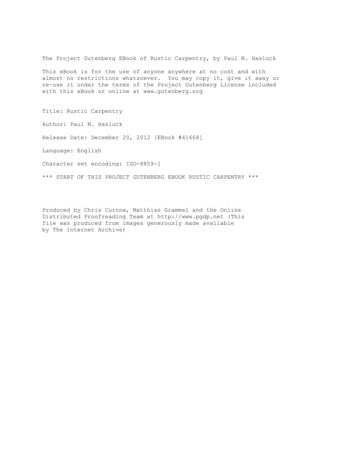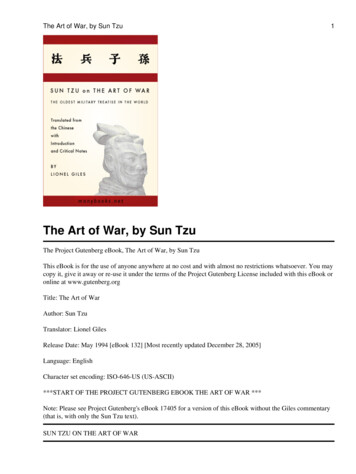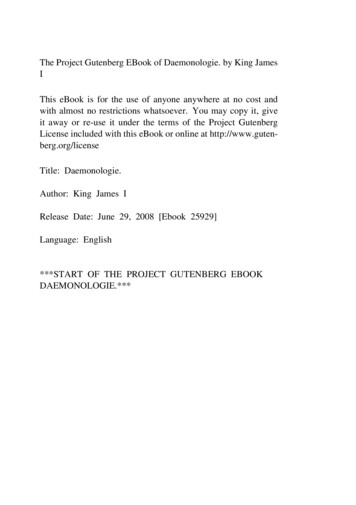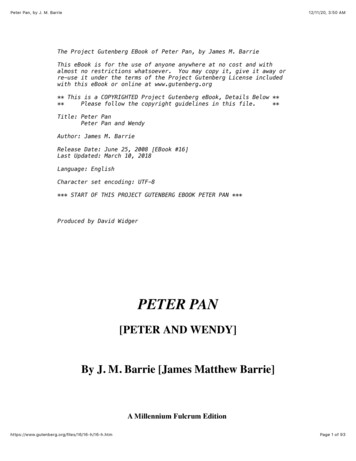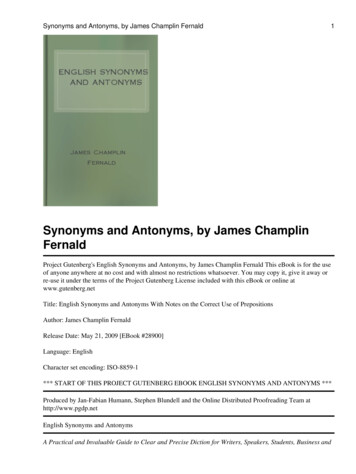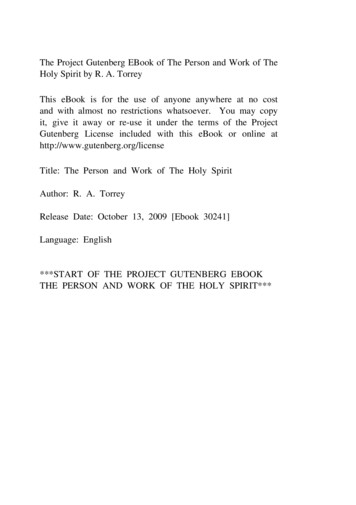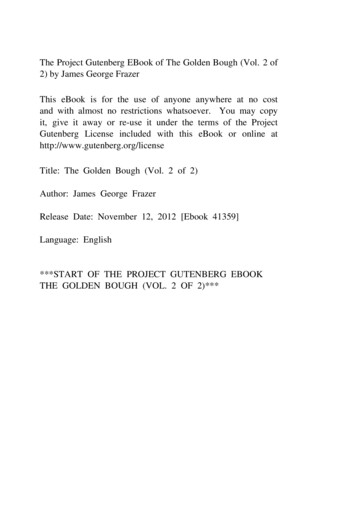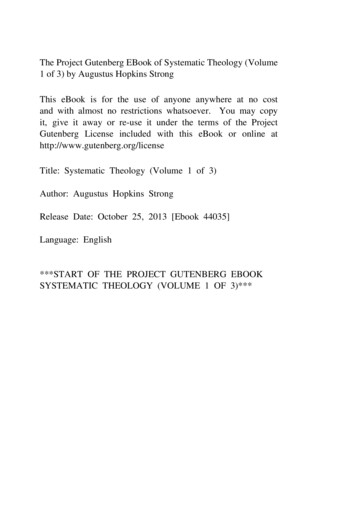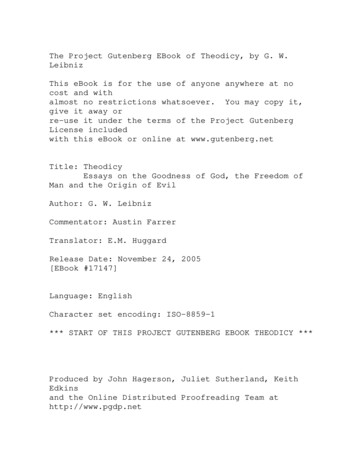
Transcription
The Project Gutenberg EBook of Theodicy, by G. W.LeibnizThis eBook is for the use of anyone anywhere at nocost and withalmost no restrictions whatsoever. You may copy it,give it away orre-use it under the terms of the Project GutenbergLicense includedwith this eBook or online at www.gutenberg.netTitle: TheodicyEssays on the Goodness of God, the Freedom ofMan and the Origin of EvilAuthor: G. W. LeibnizCommentator: Austin FarrerTranslator: E.M. HuggardRelease Date: November 24, 2005[EBook #17147]Language: EnglishCharacter set encoding: ISO-8859-1*** START OF THIS PROJECT GUTENBERG EBOOK THEODICY ***Produced by John Hagerson, Juliet Sutherland, KeithEdkinsand the Online Distributed Proofreading Team athttp://www.pgdp.net
TheodicyEssays onthe Goodness of Godthe Freedom of Man andthe Origin of EvilG.W. LEIBNIZEdited with an Introduction by Austin Farrer, Fellow ofTrinity College, OxfordTranslated by E.M. Huggard fromC.J. Gerhardt's Edition of the Collected PhilosophicalWorks, 1875-90OpenCourt , La Salle, Illinois 61301
OPEN COURT and the above logo are registered in the U.S. Patent & TrademarkOffice.Published 1985 by Open Court Publishing Company, Peru, Illinois 61354.This edition first published 1951 by Routledge & Kegan Paul Limited, London.Second printing 1988Third printing 1990Fourth printing 1993Fifth printing 1996Printed and bound in the United States of America.Library of Congress Cataloging-in-Publication DataLeibniz, Gottfried Wilhelm, Freiherr von, 1646-1716.Theodicy: essays on the goodness of God, thefreedom of man, and the origin of evil.Translation of: Essais de Théodicée.Includes index.1. Theodicy Early works to 1800. I. Title.B2590.E5 1985 231'.8 85-8833ISBN O-87548-437-9
[5]CONTENTSEDITOR'S INTRODUCTIONPREFACEPRELIMINARY DISSERTATION ON THE CONFORMITY OFFAITH WITH REASONESSAYS ON THE JUSTICE OF GOD AND THE FREEDOMOF MAN IN THE ORIGIN OF EVIL, IN THREE PARTSAPPENDICESSUMMARY OF THE CONTROVERSY, REDUCED TOFORMAL ARGUMENTSEXCURSUS ON THEODICY, § 392REFLEXIONS ON THE WORK THAT MR. HOBBESPUBLISHED IN ENGLISH ON 'FREEDOM, NECESSITY ANDCHANCE'OBSERVATIONS ON THE BOOK CONCERNING 'THEORIGIN OF EVIL', PUBLISHED RECENTLY IN LONDONCAUSA DEI ASSERTAINDEXpage 74973123, 182, 276377389393405443445
[7]EDITOR'S INTRODUCTIONILeibniz was above all things a metaphysician. That does not mean that his headwas in the clouds, or that the particular sciences lacked interest for him. Not atall he felt a lively concern for theological debate, he was a mathematician of thefirst rank, he made original contributions to physics, he gave a realistic attention tomoral psychology. But he was incapable of looking at the objects of any specialenquiry without seeing them as aspects or parts of one intelligible universe. Hestrove constantly after system, and the instrument on which his effort relied wasthe speculative reason. He embodied in an extreme form the spirit of his age.Nothing could be less like the spirit of ours. To many people now alivemetaphysics means a body of wild and meaningless assertions resting on spuriousargument. A professor of metaphysics may nowadays be held to deal handsomelywith the duties of his chair if he is prepared to handle metaphysical statements atall, though it be only for the purpose of getting rid of them, by showing them up asconfused forms of something else. A chair in metaphysical philosophy becomesanalogous to a chair in tropical diseases: what is taught from it is not thepropagation but the cure.Confidence in metaphysical construction has ebbed and flowed throughphilosophical history; periods of speculation have been followed by periods ofcriticism. The tide will flow again, but it has
[8]not turned yet, and such metaphysicians as survive scarcely venture further than toargue a case for the possibility of their art. It would be an embarrassing task toopen an approach to Leibnitian metaphysics from the present metaphysicalposition, if there is a present position. If we want an agreed starting-point, it willhave to be historical.The historical importance of Leibniz's ideas is anyhow unmistakable. Ifmetaphysical thinking is nonsensical, its empire over the human imagination muststill be confessed; if it is as chimerical a science as alchemy, it is no less fertile inby-products of importance. And if we are to consider Leibniz historically, wecannot do better than take up his Theodicy, for two reasons. It was the only one ofhis main philosophical works to be published in his lifetime, so that it was aprincipal means of his direct influence; the Leibniz his own age knew was theLeibniz of the Theodicy. Then in the second place, the Theodicy itself is peculiarlyrich in historical material. It reflects the world of men and books which Leibnizknew; it expresses the theological setting of metaphysical speculation which stillpredominated in the first years of the eighteenth century.Leibniz is remembered for his philosophy; he was not a professional philosopher.He was offered academic chairs, but he declined them. He was a gentleman, aperson of means, librarian to a reigning prince, and frequently employed in stateaffairs of trust and importance. The librarian might at any moment become thepolitical secretary, and offer his own contributions to policy. Leibniz was for thegreater part of his active life the learned and confidential servant of the House ofBrunswick; when the Duke had nothing better to do with him, he set him toresearch into ducal history. If Leibniz had a profession in literature, it was historyrather than philosophy. He was even more closely bound to the interests of hisprince than John Locke was to those of the Prince of Orange. The Houses ofOrange and of Brunswick were on the same side in the principal contest whichdivided Europe, the battle between Louis XIV and his enemies. It was a turningpoint of the struggle when the Prince of Orange supplanted Louis's Stuart friendson the English throne. It was a continuation of the same movement, whenLeibniz's master, George I, succeeded to the same throne, and frustrated therestoration of the Stuart heir. Locke returned to England in the wake of the Prince
[9]of Orange, and became the representative thinker of the régime. Leibniz wished tocome to the English court of George I, but was unkindly ordered to attend to theduties of his librarianship. So he remained in Hanover. He was then an old man,and before the tide of favour had turned, he died.Posterity has reckoned Locke and Leibniz the heads of rival sects, but politicallythey were on the same side. As against Louis's political absolutism and enforcedreligious uniformity, both championed religious toleration and the freedom of themind. Their theological liberalism was political prudence; it was not necessarilyfor that reason the less personally sincere. They had too much wisdom to meetbigotry with bigotry, or set Protestant intolerance against Catholic absolutism. Butthey had too much sympathy with the spirit of Europe to react into free thinking orto make a frontal attack on revealed truth. They took their stand on a fundamentalChristian theism, the common religion of all good men; they repudiated thenegative enormities of Hobbes and Spinoza.The Christian was to hold a position covered by three lines of defences. The baseline was to be the substance of Christian theism and of Christian morals, and it wasto be held by the forces of sheer reason, without aid from scriptural revelation. Themiddle line was laid down by the general sense of Scripture, and the defence of itwas this. 'Scriptural doctrine is reconcilable with the findings of sheer reason, butit goes beyond them. We believe the Scriptures, because they are authenticated bymarks of supernatural intervention in the circumstances of their origin. We believethem, but reason controls our interpretation of them.' There remained the mostforward and the most hazardous line: the special positions which a Church, a sect,or an individual might found upon the scriptural revelation. A prudent man wouldnot hold his advance positions in the same force or defend them with the sameobstinacy as either of the lines behind them. He could argue for them, but he couldnot require assent to them.One cannot help feeling, indeed, the readiness of these writers to fall back, notonly from the front line to the middle line, but from the middle line itself to thebase line. Leibniz, for example, writes with perfect seriousness and decency aboutthe Christian scheme of redemption, but it hardly looks like being for him a crucialdeliverance from perdition. It is not the intervention of Mercy,
[10]by which alone He possesses himself of us: it is one of the ways in which supremeBenevolence carries out a cosmic policy; and God's benevolence is known by purereason, and apart from Christian revelation.In one politically important particular the theological attitude of Leibniz differedfrom that of Locke. Both stood for toleration and for the minimizing of thedifferences between the sects. This was a serious enough matter in England, but itwas an even more serious matter in Germany. For Germany was divided betweenCatholics and Protestants; effective toleration must embrace them both. Englishtoleration might indulge a harmless Catholic minority, while rejecting the Catholicrégime as the embodiment of intolerance. But this was not practical politics on theContinent; you must tolerate Catholicism on an equal footing, and come to termswith Catholic régimes. Leibniz was not going to damn the Pope with trueProtestant fervour. It was his consistent aim to show that his theological principleswere as serviceable to Catholic thinkers as to the doctors of his own church. Onsome points, indeed, he found his most solid support from Catholics; in otherplaces there are hints of a joint Catholic-Lutheran front against Calvinism. But onthe whole Leibniz's writings suggest that the important decisions cut across all theChurches, and not between them.Leibniz was impelled to a compromise with 'popery', not only by the religiousdivisions of Germany, but (at one stage) by the political weakness of the GermanProtestant States. At the point of Louis XIV's highest success, the Protestantprinces had no hope but in Catholic Austria, and Austria was distracted by Turkishpressure in the rear. Leibniz hoped to relieve the situation by preaching a crusade.Could not the Christian princes sink their differences and unite against the infidel?And could not the Christian alliance be cemented by theological agreement? HenceLeibniz's famous negotiation with Bossuet for a basis of Catholic-Lutheranconcord. It was plainly destined to fail; and it was bound to recoil upon its author.How could he be a true Protestant who treated the differences with the Catholics asnon-essentials? How could he have touched pitch and taken no defilement?Leibniz was generally admired, but he was not widely trusted. As a merepolitician, he may be judged to have over-reached himself.It has been the object of the preceding paragraphs to show that
[11]Leibniz the politician and Leibniz the theologian were one and the same person;not at all to suggest that his rational theology was just political expediency. Wemay apply to him a parody of his own doctrine, the pre-established harmonybetween nature and grace. Everything happens as though Leibniz were a liberalpolitician, and his theology expressed his politics. Yes, but equally, everythinghappens as though Leibniz were a philosophical theologian, and his politicsexpressed his theology. His appreciation of Catholic speculation was natural andsincere; his dogmatic ancestry is to be looked for in Thomism and Catholichumanism as much as anywhere. Above all, he had himself a liberal and generousmind. It gave him pleasure to appreciate good wherever he could see it, and todiscover a soul of truth in every opinion.From the moment when Leibniz became aware of himself as an independentthinker, he was the man of a doctrine. Sometimes he called it 'my principles',sometimes 'the new system', sometimes 'pre-established harmony'. It could be quitebriefly expressed; he was always ready to oblige his friends with a summarystatement, either in a letter or an enclosed memorandum, and several such havecome down to us. The doctrine may have been in Leibniz's view simple, but it wasapplicable to every department of human speculation or enquiry. It provided a newalphabet of philosophical ideas, and everything in heaven and earth could beexpressed in it; not only could be, but ought to be, and Leibniz showed tirelessenergy in working out restatements of standing problems.As a man with an idea, with a philosophical nostrum, Leibniz may be compared toBishop Berkeley. There was never any more doubt that Leibniz was a Leibnitianthan that Berkeley was a Berkeleian. But there is no comparison between the twomen in the width of their range. About many things Berkeley never took thetrouble to Berkeleianize. To take the most surprising instance of his neglect heassured the world that his whole doctrine pointed to, and hung upon, theology. Butwhat sort of a theology? He scarcely took the first steps in the formulation of it. Hepreferred to keep on defending and explaining his esse est percipi. With Leibniz itis wholly different; he carries his new torch into every corner, to illuminate thedark questions.The wide applicability of pre-established harmony might come home to itsinventor as a rich surprise. The reflective historian will
[12]find it less surprising, for he will suspect that the applications were in view fromthe start. What was Leibniz thinking of when the new principle flashed upon him?What was he not thinking of? He had a many-sided mind. If the origins of theprinciple were complex, little wonder that its applications were manifold. Everyexpositor of Leibniz who does not wish to be endlessly tedious must concentrateattention on one aspect of Leibniz's principle, and one source of its origin. We willhere give an account of the matter which, we trust, will go most directly to theheart of it, but we will make no claims to sufficient interpretation of Leibniz'sthought-processes.Leibniz, then, like all the philosophers of the seventeenth century, was reformingscholasticism in the light of a new physical science. The science was mathematicalin its form, mechanistical in its doctrine, and unanswerable in its evidence it gotresults. But it was metaphysically intractable, and the doctrines of infinite andfinite substance which it generated furnish a gallery of metaphysical grotesques;unless we are to except Leibniz; his system is, if nothing else, a miracle ofingenuity, and there are moments when we are in danger of believing it.It is a natural mistake for the student of seventeenth-century thought tounderestimate the tenacity of scholastic Aristotelianism. Descartes, we all know,was reared in it, but then Descartes overthrew it; and he had done his work anddied by the time that Leibniz was of an age to philosophize at all. We expect to seeLeibniz starting on his shoulders and climbing on from there. We are disappointed.Leibniz himself tells us that he was raised in the scholastic teaching. Hisacquaintance with Descartes's opinions was second-hand, and they were retailed tohim only that they might be derided. He agreed, like an amiable youth, with hispreceptors.The next phase of his development gave him a direct knowledge of Cartesianwritings, and of other modern books beside, such as those of the atomist Gassendi.He was delighted with what he read, because of its fertility in the field of physicsand mathematics; and for a short time he was an enthusiastic modern. Butpresently he became dissatisfied. The new systems did not go far enough, theywere still scientifically inadequate. At the same time they went too far, and carriedmetaphysical paradox beyond the limits of human credulity.
[13]There is no mystery about Leibniz's scientific objections to the new philosophers.If he condemned them here, it was on the basis of scientific thought andobservation. Descartes's formulation of the laws of motion could, for example, berefuted by physical experiment; and if his general view of physical nature wasbound up with it, then so much the worse for the Cartesian philosophy. Butwhence came Leibniz's more strictly metaphysical objections? Where had helearned that standard of metaphysical adequacy which showed up the inadequacyof the new metaphysicians? His own disciples might be satisfied to reply, that helearnt it from Reason herself; but the answer will not pass with us. Leibnizreasoned, indeed, but he did not reason from nowhere, nor would he have gotanywhere if he had. His conception of metaphysical reason was what his earlyscholastic training had made it.There are certain absurd opinions which we are sure we have been taught,although, when put to it, we find it hard to name the teacher. Among them issomething of this sort. 'Leibniz was a scholarly and sympathetic thinker. He hadmore sense of history than his contemporaries, and he was instinctively eclectic.He believed he could learn something from each of his great predecessors. We seehim reaching back to cull a notion from Plato or from Aristotle; he even foundsomething of use in the scholastics. In particular, he picked out the Aristotelian"entelechy" to stop a gap in the philosophy of his own age.' What this form ofstatement ignores is that Leibniz was a scholastic: a scholastic endeavouring, likeDescartes before him, to revolutionize scholasticism. The word 'entelechy' was,indeed, a piece of antiquity which Leibniz revived, but the thing for which it stoodwas the most familiar of current scholastic conceptions. 'Entelechy' means activeprinciple of wholeness or completion in an individual thing. Scholasticism wascontent to talk about it under the name of 'substantial form' or 'formal cause'. Butthe scholastic interpretation of the idea was hopelessly discredited by the newscience, and the scholastic terms shared the discredit of scholastic doctrine.Leibniz wanted a term with a more general sound. 'There is an X', he wanted tosay, 'which scholasticism has defined as substantial form, but I am going to give anew definition of it.' Entelechy was a useful name for X, the more so as it had theauthority of Aristotle, the master of scholasticism.Under the name of entelechy Leibniz was upholding the soul of
[14]scholastic doctrine, while retrenching the limbs and outward flourishes. Thedoctrine of substantial form which he learnt in his youth had had something in it;he could not settle down in the principles of Descartes or of Gassendi, becauseboth ignored this vital something. Since the requirements of a new science wouldnot allow a return to sheer scholasticism, it was necessary to find a freshphilosophy, in which entelechy and mechanism might be accommodated side byside.If one had asked any 'modern' of the seventeenth century to name the 'ancient'doctrine he most abominated, he would most likely have replied, 'Substantialform'. Let us recall what was rejected under this name, and why.The medieval account of physical nature had been dominated by what we may callcommon-sense biology. Biology, indeed, is the science of the living, and themedievals were no more inclined than we are to endow all physical bodies withlife. What they did do was to take living bodies as typical, and to treat other bodiesas imperfectly analogous to them. Such an approach was a priori reasonableenough. For we may be expected to know best the physical being closest to ourown; and we, at any rate, are alive. Why not argue from the better known to theless known, from the nearer to the more remote, interpreting other things by theformula of our own being, and allowing whatever discount is necessary for theirdegree of unlikeness to us?Common-sense biology reasons as follows. In a living body there is a certainpattern of organized parts, a certain rhythm of successive motions, and a certainrange of characteristic activities. The pattern, the sheer anatomy, is basic; but itcannot long continue to exist (outside a refrigerator) without accompanying vitalrhythms in heart, respiration and digestion. Nor do these perform their partswithout the intermittent support of variable but still characteristic activities: dogsnot only breathe and digest, they run about, hunt their food, look for mates, bark atcats, and so on. The anatomical pattern, the vital rhythm, and the characteristic actstogether express dogginess; they reveal the specific form of the dog. They revealit; exactly what the specific form consisted in was the subject of much medievalspeculation. It need not concern us here.Taking the form of the species for granted, common-sense biology proceeds to askhow it comes to be in a given instance, say
[15]in the dog Toby. Before this dog was born or thought of, his form or species wasdisplayed in each of his parents. And now it looks as though the form of dog haddetached itself from them through the generative act, and set up anew on its ownaccount. How does it do that? By getting hold of some materials in which toexpress itself. At first it takes them from the body of the mother, afterwards itcollects them from a wider environment, and what the dog eats becomes the dog.What, then, is the relation of the assimilated materials to the dog-form whichassimilates them? Before assimilation, they have their own form. Before the dogeats the leg of mutton, it has the form given to it by its place in the body of asheep. What happens to the mutton? Is it without remainder transubstantiated fromsheep into dog? It loses all its distinctively sheep-like characteristicsm but theremay be some more basically material characteristics which it preserves. Theyunderlay the structure of the mutton, and they continue to underlie the structure ofthe dog's flesh which supplants it. Whatever these characteristics may be, let uscall them common material characteristics, and let us say that they belong to orcompose a common material nature.The common material nature has its own way of existing, and perhaps its ownprinciples of physical action. We may suppose that we know much or that weknow little about it. This one thing at least we know, that it is capable of becomingalternatively either mutton or dog's flesh. It is not essential to it to be mutton, ormutton it would always be; nor dog's flesh, or it would always be dog's flesh. It iscapable of becoming either, according as it is captured by one or other system offormal organization. So the voters who are to go to the polls are, by their commonnature, Englishmen; they are essentially neither Socialist curs nor Conservativesheep, but intrinsically capable of becoming either, if they become captured byeither system of party organization.According to this way of thinking, there is a certain looseness about the relation ofthe common material nature to the higher forms of organization capable ofcapturing it. Considered in itself alone, it is perhaps to be seen as governed byabsolutely determined laws of its own. It is heavy, then it will fall unlessobstructed; it is solid, then it will resist intrusions. But considered as material fororganization by higher forms, it is indeterminate. It acts in one sort of way underthe persuasion of the sheep-form, and
[16]in another sort of way under the persuasion of the dog-form, and we cannot tellhow it will act until we know which form is going to capture it. No amount ofstudy bestowed on the common material nature will enable us to judge how it willbehave under the persuasion of the higher organizing form. The only way todiscover that is to examine the higher form itself.Every form, then, will really be the object of a distinct science. The form of thesheep and the form of the dog have much in common, but that merely happens tobe so; we cannot depend upon it, or risk inferences from sheep to dog: we mustexamine each in itself; we shall really need a science of probatology about sheep,and cynology about dogs. Again, the common material nature has its ownprinciples of being and action, so it will need a science of itself, which we may callhylology. Each of these sciences is mistress in her own province; but how manythere are, and how puzzlingly they overlap! So long as we remain within theprovince of a single science, we may be able to think rigorously, everything will be'tight'. But as soon as we consider border-issues between one province and another,farewell to exactitude: everything will be 'loose'. We can think out hylology till weare blue in the face, but we shall never discover anything about the entry ofmaterial elements into higher organizations, or how they behave when they getthere. We may form perfect definitions and descriptions of the form of the dog assuch, and still derive no rules for telling what elements of matter will enter into thebody of a given dog or how they will be placed when they do. All we can be sureof is, that the dog-form will keep itself going in, and by means of, the material itembodies unless the dog dies. But what happens to the matter in the body of thedog is 'accidental' to the nature of the matter; and the use of this matter, rather thanof some other equally suitable, is accidental to the nature of the dog.No account of material events can dispense with accidental relations altogether.We must at least recognize that there are accidental relations between particularthings. Accident in the sense of brute fact had to be acknowledged even by thetidiest and most dogmatic atomism of the last century. That atomism must allow itto be accidental, in this sense, that the space surrounding any given atom wasoccupied by other atoms in a given manner. It belonged neither to the nature ofspace to be occupied by just those atoms in just those places, nor to the nature ofthe atoms to
[17]be distributed just like that over space; and so in a certain sense the environmentof any atom was an accidental environment. That is, the particular arrangement ofthe environment was accidental. The nature of the environment was not accidentalat all. It was proper to the nature of the atom to be in interaction with other atomsover a spatial field, and it never encountered in the fellow-denizens of space anyother nature but its own. It was not subject to the accident of meeting strangenatures, nor of becoming suddenly subject to strange or unequal laws ofinteraction. All interactions, being with its own kind, were reciprocal and obedientto a single set of calculable laws.But the medieval philosophy had asserted accidental relations between distinctsorts of natures, the form of living dog and the form of dead matter, for example.No one could know a priori what effect an accidental relation would produce, andall accidental relations between different pairs of natures were different: at themost there was analogy between them. Every different nature had to be separatelyobserved, and when you had observed them all, you could still simply write aninventory of them, you could not hope to rationalize your body of knowledge. Letus narrow the field and consider what this doctrine allows us to know about thewood of a certain kind of tree. We shall begin by observing the impressions itmakes on our several senses, and we shall attribute to it a substantial form such asnaturally to give rise to these impressions, without, perhaps, being so rash as toclaim a knowledge of what this substantial form is. Still we do not know what itscapacities of physical action and passion may be. We shall find them out byobserving it in relation to different 'natures'. It turns out to be combustible by fire,resistant to water, tractable to the carpenter's tools, intractable to his digestiveorgans, harmless to ostriches, nourishing to wood-beetles. Each of these capacitiesof the wood is distinct; we cannot relate them intelligibly to one another, nordeduce them from the assumed fundamental 'woodiness'.We can now see why 'substantial forms' were the bêtes noires of the seventeenthcentury philosophers. It was because they turned nature into an unmanageablejungle, in which trees, bushes, and parasites of a thousand kinds wildly interlaced.There was nothing for it, if science was to proceed, but to clear the ground andreplant with spruce in rows: to postulate a single uniform nature, of which thereshould be a single science. Now neither probatology
[18]nor cynology could hope to be universal the world is not all sheep nor all dog: itwould have to be hylology; for the world is, in its spatial aspect, all material. Letus say, then, that there is one uniform material nature of things, and that everythingelse consists in the arrangements of the basic material nature; as the show oftowers and mountains in the sunset results simply from an arrangement of vapours.And let us suppose that the interactions of the parts of matter are all like thosewhich we can observe in dead manipulable bodies in mechanism, in fact. Suchwas the postulate of the new philosophers, and it yielded them results.It yielded them results, and that was highly gratifying. But what, meanwhile, hadhappened to those palpable facts of common experience from which the wholephilosophy of substantial forms had taken its rise? Is the wholeness of a livingthing the mere resultant of the orderly operations of its parts? Is a bee no moreessentially one than a swarm is? Is the life of a living animal indistinguishablefrom the rhythm of a going watch, except in degree of complication and subtlety ofcontrivance? And if an animal's body, say my own, is simply an agglomerate ofminute interacting material units, and its wholeness is merely accidental andapparent, how is my conscious mind to be adjusted to it? For my consciousnessappears to identify itself with that whole vital pattern which used to be called thesubstantial form. We are now told that the pattern is nothing real or
Nov 24, 2005 · The Project Gutenberg EBook of Theodicy, by G. W. Leibniz . This eBook is for the use of anyone anywhere at no cost and with . almost no restrictions whatsoever. You may copy it, give it away or . re-use it under the terms of the Project Gutenberg License included . with this eBook
